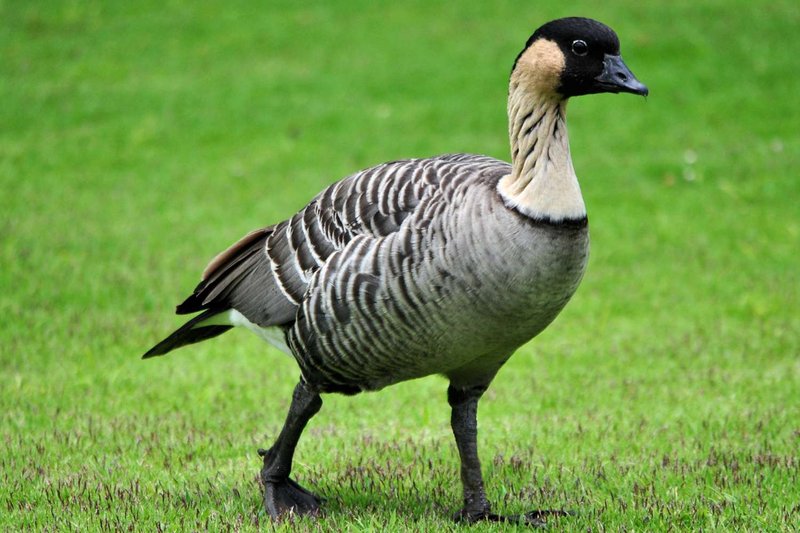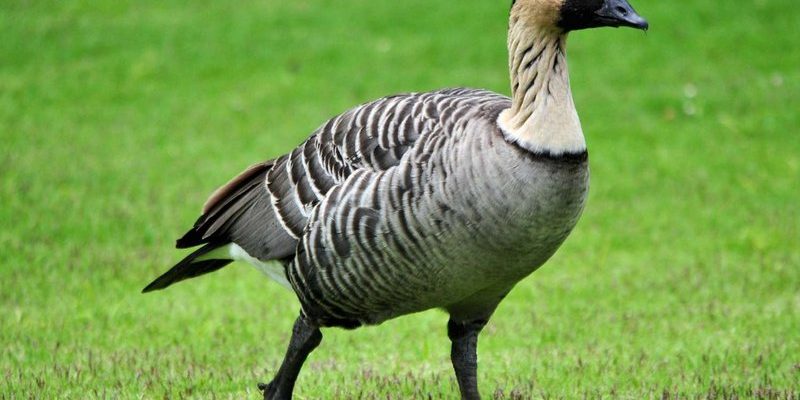
The Nene, or Hawaiian Goose, is a fascinating bird that embodies the spirit of its lush island home. Imagine a lively, graceful creature that flits around the volcanic landscapes of Hawaii, happily honking as it goes. With its striking features and unique adaptations, the Nene stands as a symbol of perseverance and resilience in the face of challenges. This bird has a remarkable story, deeply intertwined with its environment and culture.
Once on the brink of extinction, the Nene has clawed its way back to survival thanks to conservation efforts. You might be curious about how it manages to thrive in such a specific habitat and what makes it so special. Let’s dive deeper into the life of the Nene, exploring its physical characteristics, behavior, diet, and conservation status.
Physical Characteristics
The Nene is a medium-sized goose, typically standing about 2 to 3 feet tall. One of its most distinctive features is the blackish-brown plumage accented with lighter cream-colored patches on its face and neck. It has a strikingly long neck, often described as “graceful,” giving it a unique silhouette when it waddles about. Their legs are strong and adapted for walking on rocky surfaces, which is quite handy considering their native habitat.
Another interesting aspect is its webbed feet; they are not as developed as those of other waterfowl. This is because Nene prefer to stay on land rather than swim in water. Their feet are more suited for walking and running, which they do with surprising speed when they feel threatened. The Nene has a wingspan of about 4 to 4.5 feet, allowing it to fly short distances, especially when necessary for escaping predators or traveling between feeding areas.
In terms of color, Nene goslings (the young) are quite adorable, sporting a fluffy gray down. As they mature, they gradually take on the characteristic adult colors. It’s almost as if they undergo a transformation, shifting from sweet, fuzzy chicks to elegant birds of the wild. This maturation process is part of what makes watching them so delightful.
Habitat and Range
Nene are native exclusively to the Hawaiian Islands, where they thrive in various environments, from volcanic slopes to grasslands. They have adapted remarkably well to the rugged terrain. Hawaii’s unique ecosystems provide them with the necessary shelter and nourishment. You’ll often find them wandering around the lava fields, grassy plains, and even golf courses, where their quirky waddling can be quite amusing to watch.
Though historically widespread across the islands, the Nene’s population has shrunk significantly over the years. Nowadays, they primarily inhabit areas such as Hawai’i Volcanoes National Park and the high-altitude grasslands of Maui. Conservation areas are crucial for their survival since these regions offer protection from predators like dogs and cats, which pose a significant threat to their numbers.
The establishment of conservation programs has played a vital role in preserving the Nene’s habitat. Efforts include habitat restoration, predator control, and breeding programs. Their adaptability to different habitats is impressive, but the constant challenges from habitat loss and human encroachment remain critical issues.
Diet and Feeding Habits
The Nene are herbivores, primarily grazing on a diet consisting of grasses, leaves, berries, and seeds. Their preference for these natural food sources highlights their close connection to the land they inhabit. In the wild, they often forage in the early morning and late afternoon when temperatures are cooler. It’s fascinating to think about how their diet influences their behavior and movement patterns throughout the day.
Interestingly, Nene have developed a unique way to feed that suits their environment. Unlike many waterfowl that dabble in the water, Nene are comfortable foraging on land. They use their strong legs to walk over rocky terrain, searching for tender shoots and nutritious plants. This adaptability to terrestrial feeding means they can often be spotted nibbling on golf courses or meadows, much to the delight of onlookers.
One unique aspect of their feeding behavior is that they often engage in social foraging, where groups of Nene will graze together. This behavior not only helps them find food more efficiently but also strengthens social bonds within the flock. Watching a group of Nene working together to find their meals can be a joy, showcasing their communal nature.
Behavior and Social Structure
Nene are known for their charming personalities. They are quite social and often live in small family groups or flocks. Their social structure is matriarchal, meaning that females typically take the lead in flock movements and decision-making. This is fascinating because it reflects the dynamic and adaptive behavior of the species. You might even see them engaging in courtship behaviors during mating season, which can be quite entertaining.
During the breeding season, from July to March, Nene are particularly vocal. Their honks, which can be heard from a distance, serve to establish territory and attract mates. Mated pairs are incredibly devoted and will often stay together for life, raising their goslings collectively. This strong family bond contributes to the survival of their young, as both parents are involved in nurturing and protecting their chicks.
Interestingly, Nene are not confined to a specific nesting territory. Instead, they are quite flexible, often choosing to nest on the ground in secluded areas. This flexibility helps them adapt to environmental changes and disturbances. However, it also makes their nests vulnerable to predators, highlighting the ongoing challenges they face in the wild.
Conservation Status
The Nene is classified as vulnerable due to habitat loss, predation, and climate change. Once numbering in the thousands, their population dwindled drastically, reaching a low of just 30 individuals in the 1950s. Thanks to dedicated conservation efforts, the Nene has made a remarkable comeback, with current estimates showing a population of around 3,000 individuals. However, they still require ongoing support to thrive.
Various organizations have been instrumental in the Nene’s recovery, implementing breeding programs, habitat restoration, and public awareness initiatives. The collaborative efforts of wildlife organizations, local communities, and even visitors to the islands have helped ensure the Nene continues to be a part of Hawaii’s natural heritage. It’s a reminder of how interconnected we all are when it comes to protecting our planet’s biodiversity.
While the Nene’s recovery is promising, it’s essential to remain vigilant about threats that could derail these efforts. Continued habitat loss due to development and climate change poses significant risks. Educating the public about the Nene and its natural habitat is crucial for its ongoing survival. By fostering a sense of connection to this unique bird, we can inspire conservation efforts and help protect the Nene for future generations.
Interesting Facts About the Nene
| Scientific Name: | Nesochen sandwicensis |
| Size: | 2-3 feet tall |
| Wingspan: | 4-4.5 feet |
| Weight: | 3-5 pounds |
| Diet: | Grasses, leaves, berries, and seeds |
| Lifespan: | 10-20 years in the wild |
FAQ
What is the mating behavior of the Nene?
The Nene exhibits fascinating mating behaviors, especially during the breeding season. Mated pairs are known to perform elaborate courtship displays, which include vocalizations and physical displays such as head bobbing and wing flapping. These behaviors not only help solidify pair bonds but also attract potential mates. Once a pair has formed, they typically remain together for life, working together to raise their young.
How can I help conserve the Nene?
Conserving the Nene can be as simple as supporting local conservation efforts. If you’re in Hawaii, participating in guided tours that educate visitors about the Nene’s habitat and efforts to save them can make a big difference. Additionally, spreading awareness about the importance of protecting their habitats and being mindful of the impact of human activities can help ensure their survival. Every little bit counts!
Are Nene good fliers?
While Nene can fly, they are not known for their long-distance flight capabilities like some other geese species. They prefer to stay grounded, using their wings for short bursts when necessary. Typically, Nene fly short distances, especially when escaping predators or moving between feeding areas. Their legs are their primary mode of transport, and they’re surprisingly quick on their feet!
Why are Nene considered a symbol of Hawaii?
The Nene is a powerful symbol of Hawaii due to its unique adaptations and cultural significance. As the state bird of Hawaii, it represents resilience and the importance of preserving native wildlife. The efforts to save the Nene from extinction have become emblematic of broader conservation efforts in the islands, showcasing how communities can come together to protect their natural heritage.
What do Nene chicks look like?
Nene chicks, or goslings, are absolutely adorable! They are covered in soft, fluffy gray down, making them look quite different from their adult counterparts. As they grow, their feathers start to change, taking on the characteristic adult plumage of blackish-brown. Nene chicks are cared for by both parents, who are protective and attentive, ensuring their young stay safe from potential dangers.
How does climate change affect the Nene?
Climate change poses significant threats to the Nene, as it can lead to habitat loss and changes in food availability. Rising sea levels and increased storm frequency can impact their nesting sites, while changing temperatures may alter the distribution of their food sources. The Nene’s specialized habitat requirements make them particularly vulnerable to these environmental changes.
Can I see Nene in the wild?
Yes, you can see Nene in the wild, particularly in places like Hawaii Volcanoes National Park and on the slopes of Haleakalā. These areas have dedicated conservation efforts aimed at protecting the Nene and their habitats. However, it’s essential to keep a respectful distance and avoid feeding them, as this can interfere with their natural foraging behaviors and put them at risk from predators.
What role do Nene play in their ecosystem?
The Nene plays an important role in its ecosystem by helping to disperse seeds and maintain plant diversity through its grazing habits. By foraging on grasses and other vegetation, they help control plant growth and contribute to the overall health of their habitats. Their presence is a reminder of the interconnectedness of species within an ecosystem.
How long do Nene live?
Nene typically live between 10 to 20 years in the wild, although individual lifespans can vary based on environmental conditions and predation. In captive environments, where they are protected from many threats, they may live longer. Their longevity is reflective of their adaptations to their habitats and the challenges they face.
What can schools do to promote awareness about the Nene?
Schools can play a pivotal role in promoting awareness about the Nene by incorporating conservation education into their curricula. Organizing field trips to conservation areas or inviting speakers from wildlife organizations can deepen students’ understanding of the Nene and its habitat. Projects focused on local wildlife can also inspire students to engage with nature and appreciate the importance of protecting it.
Are Nene social birds?
Yes, Nene are quite social creatures. They often form small flocks or family groups and engage in social behaviors such as communal foraging and vocalizations. This social structure not only strengthens bonds within the group but also enhances their chances of survival by allowing them to work together to find food and avoid predators.

